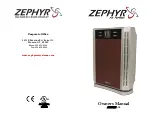
MUA-SVX004B-EN
29
Gas Controls
Single Stage Control
Gas heating units are factory provided with an automatic single-stage gas valve. This valve is an
on/off type control, typically activated by a low voltage single-stage thermostat.
1. The thermostat calls for heat.
2. The pilot valve opens.
3. The ignitor sparks continuously to ignite the pilot.
4. The sensor proves pilot ignition and shuts off the ignitor.
5. With the pilot lit, the main gas valve opens.
6. Main burners are lit at 100 percent of unit's rated input.
7. The fan time delay relay (optional) allows the heat exchanger to come up to operating
temperature. At this time, the fan time delay relay closes and activates the fan controls.
8. The unit continues to fire until the thermostat is satisfied and no longer calls for heat.
9. The main and pilot valves close.
Two-Stage Control
Optional two-stage control is provided with a two-stage gas valve capable of firing at 100% and
50% of rated input. Ignition at a low fi re (50% of the unit's rated input) and the unit is typically
controlled by a voltage two-stage thermostat.
With power applied to the unit, this system operates in the following manner:
1. The first stage of the thermostat call for heat.
2. The pilot valve opens.
3. The ignitor sparks continuously to ignite the pilot.
4. The sensor proves pilot ignition and shuts off the ignitor.
5. With the pilot lit, the main gas valve open to low fire.
6. Main burners are lit at 50 percent of unit's rated input.
7. The fan time delay relay (optional) allows the heat exchanger to come up to operating
temperature. At this time, the fan time delay closes and activates the fan motor.
8. If additional heat is required, the second stage of the thermostat calls for heat.
9. The main gas valve opens to full fire. The main burners are now at full fire. The unit continues
a full fire until the second stage of the thermostat is satisfied and no longer call for heat.
10. The main valve closes to low fire. The main burners are now at low fire. The unit continues at
low fire until the first stage of the thermostat is satisfied and no longer calls for heat.
11. The main and pilot valves closes.
12. The fan time delay remains closed, keeping the fan operating to dissipate residual heat from
the heat exchanger. At this time, the fan time delay relay opens and deactivates the fan
motor.
Electronic Modulating Control
Units with electronic modulating control are provided with an electronic modulating valve
capable of firing from 100 percent to 40 percent of rated input. Ignition is at full fire (100 percent
of unit's rated input). The electronic modulating valve is controlled by a room thermostat or duct
thermostat with remote setpoint adjustment which modulates the gas input from 100 percent to
40 percent of rated input.
An optional override room thermostat is available for use with the duct thermostat. The override
room thermostat allows full fire and overrides the duct thermostat when the room temperature
falls below the override room thermostat's setpoint.
















































